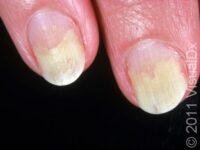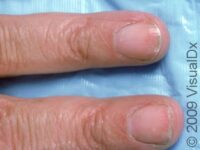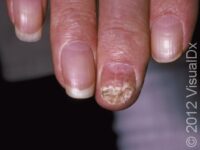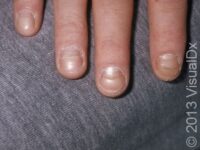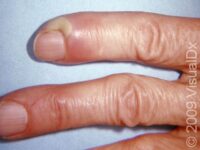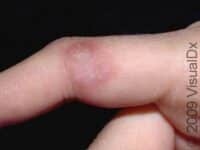Common causes of fingernail or toenail changes include trauma, aging, infection, and skin diseases. Diet is generally not responsible for abnormal nail changes, unless the person is suffering from severe malnutrition. Trauma can induce horizontal fingernail ridges (Beau lines), bleeding (hemorrhage) under the nail plate, and white streaks or spots (leukonychia). Splitting or layering of the nail plate (onychoschizia) is caused by having hands that are constantly wet, frequent use and removal of nail polish or artificial nails, and continuous mild trauma (eg, from habitual finger tapping). An ingrown toenail results from clipping the nail too short and wearing ill-fitting shoes. Vertical ridging and brittle nails are often a normal result of aging.
Toenail fungus and fingernail fungus can cause inflammation around the nail (paronychia) as well as lifting of the nail plate from the nail bed (onycholysis). Herpes infection can also cause painful swelling and blisters near the nail. Viral warts, caused by the Human Papillomavirus (HPV), may cause a change in the shape of the nail or thickened skin growth under the nail (called periungual warts). Older individuals are often affected by toenail fungus infection (onychomycosis) associated with athlete’s foot. Small, round depressions in the nail (nail pits) are seen with psoriasis or a condition that causes areas of hair loss, called alopecia areata. Psoriasis may also cause lifting, discoloration, and thickening of the nail.
Click any of pictures of nails below to learn more about what skin changes are common in fingernails and toenails.
